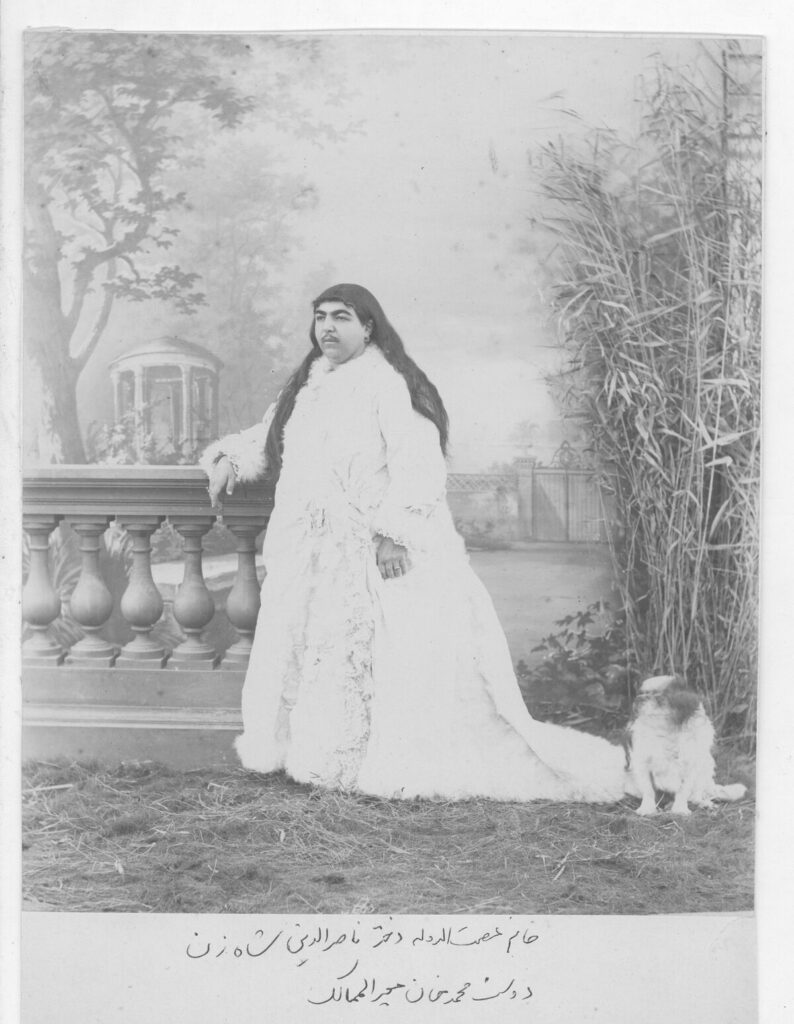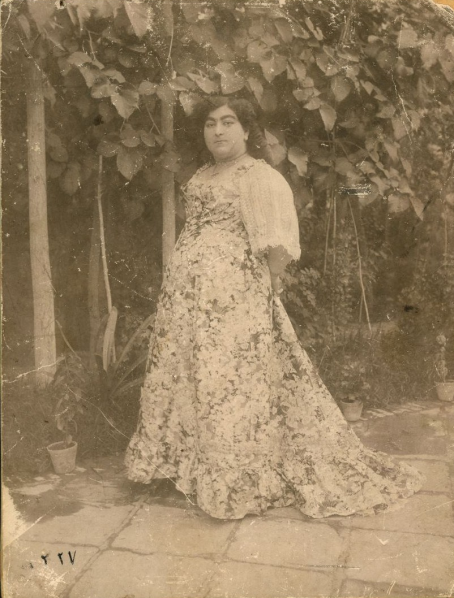The advent of the internet puts the wealth of collective human knowledge in the palm of your hand. Every historical and scientific fact, literary creation, or random idea can be found with a quick search.
But with so much information, it is sometimes a struggle to determine between fact and fiction.


With increased internet access and the rise of social media, people have been able to post anything and claim that it is true.
In particular, posts that evoke outrage or challenge people’s existing perceptions of the world tend to go the most viral. One recent example is a viral meme of a person that the post calls “Princess Qajar.”
The image, which has gone viral several times, depicts a woman with a mustache dressed in a long, flowing dress and sometimes includes a headshot as well.
The caption on the image claims that “Princess Qajar” was the epitome of beauty in Persia and that 13 young men took their own lives after being rejected by her.
The post is designed to subvert beauty expectations by framing a mustached woman as attractive, something typically not considered true today.
And the idea that she was desirable enough that not just one, but 13 men took such drastic lengths after being rejected adds to the absurdity.
That is because it is absurd. The claim that 13 men ended their own lives over this woman has no evidence to support it. In fact, even the woman’s identity is incorrect.
There was never one person named “Princess Qajar”, as the name was derived from the ruling dynasty.
The meme even gets wrong that the headshot and full body shot are the same woman. They were actually two different princesses, who shared a father.
Naser al-Din Shah Qajar was the fourth Shah of Iran who attempted to modernize the nation starting in 1848.
He had 22 children throughout his life, including the two women featured in the viral meme. This has led to the women being mistaken for each other over time.
Princess Ismat al-Dawlah
The woman standing in the white dress is Princess Fatimah Khanum, also known as Ismat al-Dawlah.

Born in 1855, al-Dawlah was the third eldest daughter of Naser al-Din Shah Qajar. Her mother was Taj al-Dawlah, a royal consort who had been previously wedded to another Shah.
As a young member of the royal family, she got to experience a life of luxury, with her finger on the pulse of modernity. As her father traveled to Europe and opened the nation to the modern industrial world, al-Dawlah got to experience new wonders.
For example, she became the first woman in Iran to learn how to play the piano, a pursuit she continued throughout life.
At the age of 12, she was married off to the 10-year-old son of another Iranian elite. As she spent her life in a position of power, she came to fulfill the role well.
She hosted other diplomats’ wives in her home and even negotiated to allow her husband to return home after he had secretly left the country.
Unfortunately, not much else is known about al-Dawlah besides the fact that her life demonstrates the rapidly evolving role of women in Iranian society during the 19th century.
However, it seems unlikely that a girl who married away at 12 would have had the chance to deny 13 other men.
Princess Zahra Khanom
The other woman in the viral image is al-Dawlah’s sister, whose life was more extensively recorded. Her name was Zahra Khanom, or Taj al-Saltaneh, and she was the third to last daughter of Naser al-Din Shah Qajar.

Born in the mid-19th century, her life came to encapsulate the rapid modernization that her country was facing. Moreso than her sister’s, a glance at Khanom’s life offers a window into a transformative period of Iran’s history.
Khanom was born in 1883, to her father, Naser al-Din Shah Qajar, and Tooran al-Saltaneh, a royal consort. As with her sister, Khanom’s role in the royal family offered her the unique experience of embracing the modern world.
Throughout her life, she used her position to immerse herself in the humanities, and more importantly, social justice.
And while she has been remembered widely for her contributions to the feminist movement, she has also become a symbol of alternative beauty through a viral meme hundreds of years later.
An Intellectual And Feminist
Khanom was a remarkable intellectual. As a princess, she had access to a comprehensive education, which was rare for women in Iran at the time. She studied languages, music, and the arts, becoming a prolific writer and poet while mastering multiple languages.
Utilizing her unique opportunities, Khanom contributed significantly to the rising feminist movement. Within a rapidly changing Iranian society, she advocated for women’s rights from a place of power.
In the first decade of the 20th century, she helped to found the underground women’s rights group, the Women’s Freedom Association.
Claiming to be attending religious services, Khanom would sneak away to meetings and organize various events and protests. She dedicated her life to advocating for women’s rights and helping organize the feminist movement.
In her memoirs, Khanom expressed her views on gender equality and criticized restrictions on women’s freedoms. She believed that receiving an education would empower women to take active roles in public life, especially since it had opened up her own world.
She was also an abolitionist who opposed the institution of slavery. Throughout her childhood, she was left in the care of African slaves called “bondservants.”
In her memoirs, Khanom expressed sympathy for her caretakers, lamenting that they faced such a tragic life simply for the color of their skin.
Her writings and speeches inspired many women to seek education and fight for their rights, laying the groundwork for future generations of Iranian feminists.
Her works were published in 1996 collectively under the title Crowning Anguish: Memoirs of a Persian Princess from the Harem to Modernity 1884 – 1914. The original handwritten memoir is currently held at Iran’s National Library.
Challenges And Controversies
Although her role as a princess offered her many opportunities in life, Khanom also faced setbacks in her position.
Similar to her father, Khanom faced conservative opposition to modernization and feminist strides in Iran. Her outspoken nature and progressive views often put her at odds with the more traditional factions of the Qajar court.
Her personal life also reflected the complexities of her era. She was forced into an arranged marriage with Sardar Hassan al-Saltaneh.
Betrothed at age 8 and married at 13, Khanom was deeply unhappy with the arrangement.
She later wrote of her discomfort with the idea, the fear of having an abortion to avoid death during childbirth at a young age, and the pain of her husband having multiple affairs.
Despite having four children, Khanom eventually divorced al-Saltaneh. This made her one of the earliest members of the royal family to do so, as divorce was uncommon and controversial.
However, her defiance of gender roles and desire for women’s freedom inspired her to break boundaries and seek happiness, eventually leading to a second divorce as well.
Also controversially, she was very vocal about the monarchy and its failures despite being a member of the royal family.
She criticized both her brother and father while they were Shah, claiming that a democratic system could save the nation from the incompetency of the monarchy.
This contributed to the turbulent political landscape of Iran during her lifetime. The Constitutional Revolution (1905-1911) was a period of significant upheaval, as Iranians sought to limit the powers of the monarchy and establish a constitutional government.
Khanom fully supported the movement and did everything in her power to support it. As one of the few women with extensive education, she was a lone female voice in the fight for democracy.
So Much More Than Beautiful
Despite all of her political activism, Khanom’s legacy has, in part, still been boiled down to the way that she looks.
The Princess Qajar meme is slightly accurate in that Khanom or al-Dawlah having a slight mustache was a standard of beauty in 19th-century Iran.
But it is insulting to boil down the talent and hard work done by either princess to their looks. Claiming that their most important historical contribution was a fictional claim insults these women’s lives.
al-Dawlah was an accomplished unofficial diplomat, while Khanom’s work is the subject of Middle Eastern studies at universities around the globe.
Contextualizing their beauty within their larger societal contributions is essential to understanding their role in the fledgling feminist movement of 19th-century Iran.
The story of Princess Qajar is a good reminder to not believe everything you see on the internet.
The two women presented in the popular meme were more than just beautiful princesses; they were educated and powerful women. Their contributions reshaped Iranian society and continue to inspire feminist thought.
Sources
https://abitofhistoryblog.com/2017/12/12/princess-qajar-and-the-problem-with-history-memes













Leave a comment